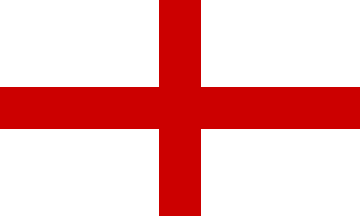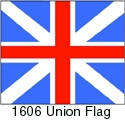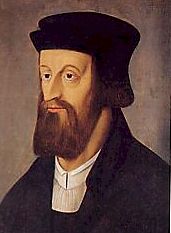The St. George Flag
 This
is the flag of England, first used, it's believed, in the 13th century.
(It's also used for the city of Montreal, except that
that flag adds four symbols: the fleur-de-lys of France, the rose of England,
the thistle of Scotland, and the shamrock of Ireland).
This
is the flag of England, first used, it's believed, in the 13th century.
(It's also used for the city of Montreal, except that
that flag adds four symbols: the fleur-de-lys of France, the rose of England,
the thistle of Scotland, and the shamrock of Ireland).
The British isles outside England
 Ireland.
Henry II of England, on the authority of a papal bull which is thought
to be a forgery, laid claim to Ireland in 1155. Anglo-Norman settlers
gradually took power. Henry VII in the 1490s sought to strengthen
English control there.
Ireland.
Henry II of England, on the authority of a papal bull which is thought
to be a forgery, laid claim to Ireland in 1155. Anglo-Norman settlers
gradually took power. Henry VII in the 1490s sought to strengthen
English control there.
After the Reformation, rebellions, reprisals, acts of terrorism, and battles between English and Irish were frequent. The best known battle was at the river Boyne, July 12, 1690, where William III of England (William of Orange) was victorious — hence the name Orangemen for Protestant Irish loyal to the English crown, and the annual July 12 parades which often turned to violence in Canadian towns in the nineteenth and earlier twentieth centuries. In 1800, Protestants in the Irish Parliament, perceiving threats to their security, passed an Act of Union bringing Ireland into the new United Kingdom of Great Britain and Ireland. After a rebellion at Easter 1916, Irish revolutionary sentiment gathered steam, and the southern part of Ireland won independence from in 1922.
 Wales.
War between England and Wales was intermittent until Edward I subjugated
it in 1284, and it became an English principality. In 1536 an Act
of Union incorporated Wales into England.
Wales.
War between England and Wales was intermittent until Edward I subjugated
it in 1284, and it became an English principality. In 1536 an Act
of Union incorporated Wales into England.
After the Reformation, Welsh nationalist sentiment continued. In the 1990s the Blair government accommodated Welsh nationalism in various ways, particularly by creating a Welsh assembly which first convened in 1999.
 Scotland.
James VI of Scotland inherited the English throne in 1603, thus
bringing the two kingdoms under a single crown. An Act of Union
in 1707 united the two kingdoms, creating Great Britain. Scottish
nationalist sentiment continued and developed, and in the 1990s the Labour
government under Tony Blair decided to restore the Scottish Parliament,
which convened in 1999.
Scotland.
James VI of Scotland inherited the English throne in 1603, thus
bringing the two kingdoms under a single crown. An Act of Union
in 1707 united the two kingdoms, creating Great Britain. Scottish
nationalist sentiment continued and developed, and in the 1990s the Labour
government under Tony Blair decided to restore the Scottish Parliament,
which convened in 1999.
 At
the union of England and Scotland, a new flag combined England's cross
of St. George with Scotland's cross of St. Andrew.
At
the union of England and Scotland, a new flag combined England's cross
of St. George with Scotland's cross of St. Andrew.
Europe and England
The Norman Conquest brought English Christianity out of its insular existence fully into the European context. The Conqueror brought in monks and clergy from Normandy, and granted them land.
- Monasteries and universities. England’s new connections with European monasteries and academic centres and soon its participation in the new university movement (Oxford, perhaps 1167?) brought it more into the theological mainstream.
- Popes. Moreover, just a few years after the Conquest (1073), Hildebrand became Pope Gregory VII, the great reformer, centralizer, and champion of ecclesiastical powers against the secular lords; the Gregorian reform movement culminated in the Fourth Lateran Council, 1215. After a generation or two, England felt this reform.
- Administration. William the Conqueror appointed as his first archbishop Lanfranc, d. 1089, an Italian who was the prior of a monastery in Normandy, who got rid of most of the Anglo-Saxon bishops, and summoned several church councils to regularize administration and lines of accountability.
- Theology. The successor of Lanfranc was Anselm of Canterbury, d. 1109, another Italian immigrant to Normandy, and a pupil of Lanfranc’s. He was one of the most distinguished and influential of early Scholastics. (He was less happy as an administrator, and, quarreling with King Henry I, endured two periods of exile.)
- Abuse. By the early 16th century, on the eve of the Reformation, the influence of Europeans in England was a source of scandal. There were bishops of English dioceses and rectors of English parishes and staff members of English cathedrals who didn’t live in England, or who, if they did, didn’t speak English. One motive for Reformation under Henry VIII would be nationalism.
Church and state
The history of Western Christianity in the later Middle Ages has been described as a perpetual border warfare between church and state.
In England these tensions are concentrated in the story of Thomas à Becket, d. 1170. King Henry II aimed to control the Church, which Becket resisted. (Special study for part of the class: What are the premises, dynamics, and ramifications of the martyrdom of Becket?) Note: you may know a movie version of Becket, with Richard Burton and Peter O'Toole. It's based on a play by Jean Anouilh, first performed in Paris in 1944 as a slightly disguised act of protest against the Nazi occupation. For Anouilh, the story of Becket could be seen as the conflict of the moral conscience with state power.
After King John refused the Pope’s appointment of an Archbishop in 1207, the Pope placed England under an interdict. John finally submitted, 1213. The new archbishop, Stephen Langton, led the barons and clergy to impose Magna Carta, 1215.
Friars
Although monasteries were financially strong until the Reformation, their spiritual health and influence appear to have diminished by the end of the thirteenth century. About that time there emerged the various orders of friars, who lived among the people, not in monasteries, and were noted as evangelists, preachers, writers, pastors, and scholars. But these, too, were losing their popularity by the time of Chaucer.
Scholasticism
This academic method of identifying theological issues, laying out two sides to the issue, weighing the pro’s and con’s of each side, and then coming to a conclusion, dominated the theological enterprise from the thirteenth to the sixteenth centuries (and in many ways is with us still). Some of the greatest Scholastics were from Britain, notably Roger Bacon, d. ca. 1292; Duns Scotus, d. 1308; and William of Occam, d. 1347.
 Heresy
Heresy
The greatest British heretic since Pelagius was John Wyclif, d. 1384. His later writings reflect the influence of the Great Schism (when two, then three popes contended for recognition, 1378–1417). One of the most noted scholastics of his day, he wrote the first full commentary on Scripture in almost a thousand years, and was named “the evangelical doctor”. He championed the authority of Scripture over the authority of tradition and the papal office, and critiqued the defects of the mass, in a way that some later thought foreshadowed the Reformation — hence his epithet, “the Morning Star of the Reformation”. His clandestine followers, the Lollards, survived considerable persecution and can still be found in the early days of the Reformation in the 1520s. He was also influential on the continent, particularly among the Hussites of Bohemia.
Parish life
Church building. The thirteenth and fourteenth centuries were busy with the building of churches, leaving us with the characteristic English landscape of a church conspicuously placed in every village. The church was the centre of community social life. Like the society of the day, it was hierarchically ordered.
Parish clergy were highly diverse socially and educationally. The seminary system did not yet exist: “this is perhaps the most important of all differences between the clergy of medieval and modern times.” Manuals of instruction for parish clergy abounded.
Church finance. Every position in the church was both office and benefice. Vicars were appointed; pluralism and non-residence of clergy resulted.
The laity. After the Fourth Lateran Council, we find a laity increasing in education and commitment, and on the eve of the Reformation a variety of lay guilds and associations with a strong appetite for religious literature and discussion.
Saints, shrines, pilgrimage
This gives us a window on the “popular religion” of the later middle ages. Chaucer’s Canterbury Tales was a special study for some in the class.
Mysticism
In the century or so from about 1325 to 1425 England made a weightier contribution to Christian mysticism than it ever had before or ever has since. Examples are Julian of Norwich, d. after 1413 (a special study for some in the class); Margery Kempe, d. after 1433, accused of Lollardy; Richard Rolle, d. 1349, and the author of The Cloud of Unknowing, 14th century.
Renaissance
By the late 1400s, the continental Renaissance is being felt in England, notably in John Colet, d. 1519, dean of St. Paul’s. His lectures at Oxford on St. Paul in 1497 were in the new humanistic tradition (in the Renaissance sense of ‘humanism’).
ALH